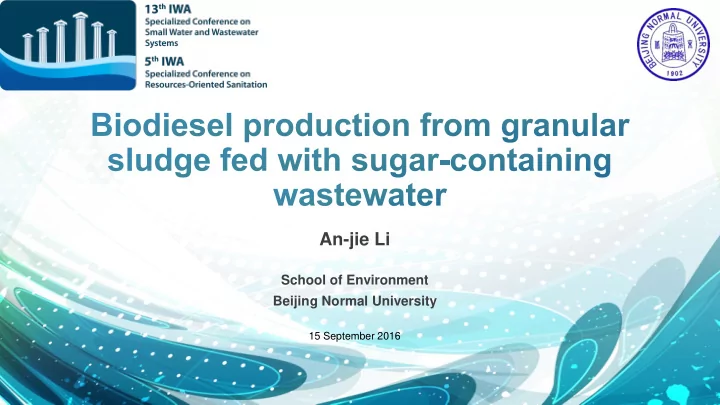

An-jie Li School of Environment Beijing Normal University 15 September 2016
Introduction Great energy demand Energy crisis Greenhouse gas emission Increasing interest in Global warming renewable energy Air pollution 2
Introduction Biodiesel is a petroleum diesel substitute produced by transesterification of lipid feedstock that yields the methyl esters of the fatty acids (FAMEs) . (Knothe, 2005 ) High cetane number and flash point Low air pollutants emission Biodiesel Nontoxic Completely degradable Excellent lubricity 3
Introduction Plant oils Animal fats Microbial lipid The high cost of lipid feedstock has restricted the commercialization of biodiesel production (>70% of the overall production cost) (Zhao and Hu, 2011). 4
Introduction Low cost Low lipid content Sustainable supply 1. Increasing the organic loading (Mondala et al., 2012) 2. Increasing C/N (Mondala et al., 2012) 3. Utilizing different carbon sources (Mondala et al.,2013, 2015) Promote lipid accumulation 5
Introduction small-scale wastewater system Activated Aerobic sludge granule Size (mm) <0.5 0.2-5 Bioflocs Granules SVI (ml/g) 70-150 20-80 Settling velocity 5.8-17.6 30-70 (m/h) 1.004- Specific gravity 1.002 1.064 Integrity - > 95 coefficient (%) 6
AGS Reutilization Wastewater Biodiesel Using granular sludge(GS) to treat sugar-containing wastewater with high organic concentration and to produce biodiesel. 7
Granular sludge 1. synthetic sugar-containing wastewater treatment 2. biodiesel production Operation parameters seed sludge concentration, HRT and sludge loading rate lipid accumulation of granular sludge Microbial structure the relationships among operation conditions, characteristics of sludge and biodiesel production 8
Materials and methods Sludge Initial MLSS HRT Settling Phase Reactor discharge (g/L ) ( h ) time (min) ( mL/d ) 1 2.8 8 30 Start-up 30 → 2 2 2.8 8 1 8 12 2 5.3 12 2 I 3 4 12 1 8 2 8 2 II 3 8 1 8 III 2 8 2 100 3 8 150 FAMEs yield MLSS H=80 cm, D=5 cm, V=1.2L (mg/g SS) Granular FAMEs yield SVI sludge Air flow velocity: 1.0 L/min (g/L wet sludge) Glucose, NH 4 -N + COD: 2000mg/L FAMEs distribution COD:N:P=100:2:1 microbial structure 9
Materials and methods Centrifugation 2g dewatered GS 5000r/min, 5min 30mL 5% H 2 SO 4 -CH 3 OH 10mL hexane Transesterification 75 ℃ , 7h 3000r/min, 3min Centrifugation FAMEs extraction GC-FID analysis 10
Materials and methods High-throughput sequencing on Real-time Quantitative PCR Illumina MiSeq PE300 platform Microbial population structure Distribution of bacteria and fungi 16s 18S Eub338 (ACTCCTACGGGAGGCAGCAG) 18S-F (CGGCTACCACATCCAAGGAA) Primers Eub518 (ATTACCGCGGCTGCTGG) 18S-R (GCTGGAATTACCGCGGCT) 11
Results and discussion CGS showed an advantage in biodiesel production both in yield and in quality compared with CAS. Cultured activated sludge (CAS) The possible reason is the difference in the microbial community, including the growth of fungi ( Phialophora ) and a change in the bacterial population. Cultured granular sludge (CGS) 12
Results and discussion R1 R2 R3 8 36.00 II III I (a) II III I (b) Volumetric loading rate 30.00 6 (kgCOD/(m3.d)) MLSS(g/L) 24.00 4 18.00 12.00 2 The difference of initial sludge loading rate led to the different morphological features of the granules. 6.00 0 0.00 A higher sludge loading rate brought about overgrowth of white filamentous microorganism in the 1.20 150.00 (d) I II (c) III II III I granular sludge. 1.00 120.00 (kg COD/(kg MLSS·d)) Sludge loading rate 0.80 SVI(mL/g) 90.00 0.60 60.00 0.40 30.00 0.20 0.00 0.00 0 7 14 21 28 35 42 49 56 63 70 77 0 7 14 21 28 35 42 49 56 63 70 77 Days Days 13
Results and discussion GS1 GS2 GS3 100 6 (a) I II III I II III (b) 90 5 80 FAMEs (g/L wet sludge) FAMEs (mg/g SS) 4 70 Sludge loading rate might be more important than volumetric loading rate for the promotion of biodiesel 60 production from sewage sludge. 3 50 R3 with much filamentous fungi led to the highest FAMEs yield based on the dry weight, but R2 2 performed better on the volumetric FAMEs productivity. 40 1 30 20 0 0 7 14 21 28 35 42 49 56 63 70 77 0 7 14 21 28 35 42 49 56 63 70 77 Days Days 𝑮𝑩𝑵𝑭 𝒋 𝐆𝐁𝐍𝐅𝐭( 𝒏𝒉 𝒉 𝑻𝑻) = 𝑼𝒊𝒇 𝒙𝒇𝒋𝒉𝒊𝒖 𝒑𝒈 𝒆𝒔𝒛 𝒕𝒎𝒗𝒆𝒉𝒇 𝒉 𝑴 𝒙𝒇𝒖 𝒕𝒎𝒗𝒆𝒉𝒇) = 𝑮𝑩𝑵𝑭𝒕( 𝒏𝒉 𝒉 𝑻𝑻) 𝐆𝐁𝐍𝐅𝐭( 𝑻𝑾𝑱( 𝒏𝑴 𝒉 𝑻𝑻)
Results and discussion 70-day running Bacteria(%) Fungi (%) R1 67 33 Dipodascaceae R2 64 36 R3 41 59 Different initial sludge loading rate led to the distinctive microbial structure of granular sludge in the three reactors. The difference on the ratio of bacteria to fungi and bacterial population of granular sludge resulted in the different FAMEs yield and distribution. G+ bacteria at genus level 15
Compared with activated sludge, the granular sludge showed an advantage in biodiesel production both in yield and in quality. Lower seed biomass and higher initial sludge loading rate resulted in the dominance of filamentous fungi in granular sludge, which contributed to the improvement of FAMEs yield. The overgrowth of filamentous fungi would deteriorate the settling and compression ability of granular sludge, which do harm to the stability of granular sludge system and biodiesel production. Controlling the filamentous fungi at a moderate level through the effective operating strategy is of great importance to actual application of biodiesel production from granular sludge system feeding with sugar-containing wastewater. 16
National Natural Science Foundation of China (No. 51478042 ) Ms Li Mei-xi Mr Sun Qu
THANK YOU E-mail: liaj@bnu.edu.cn
Recommend
More recommend